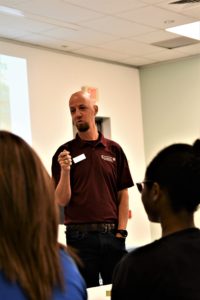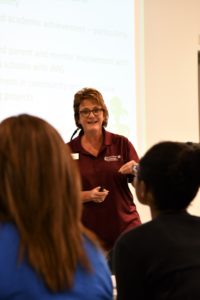Junior Master Gardener Learn, Grow, Eat & Go! Program takes shape in Houston schools
Writer: Blair Fannin, 979-845-2259, [email protected]
HOUSTON – Houston Independent School District elementary students are learning how to plant, tend and harvest nutritious vegetables thanks to the Learn, Grow, Eat & Go! program offered by the Texas A&M AgriLIfe Extension Service Junior Master Gardener Program.
Over the summer, teachers from HISD elementary schools received training on how implement the curriculum and related programming into their classrooms.

Learn, Grow, Eat & Go! is the newest curriculum in the Junior Master Gardener program that integrates gardening, nutrition, and physical activity to bolster long-term student health, said Lisa Whittlesey, AgriLife Extension program specialist and director of the International Junior Master Gardener Program, College Station.
The curriculum includes two lessons a week teaching students about plants, their needs and how a class can work together to grow a garden. Students learn about plant nutrient requirements, just like nutrients required for the human body to function properly. The students not only maintain and harvest vegetables from the garden, but take part in culinary activities preparing dishes using the vegetables.
“As with all JMG curricula, youth have the opportunity to learn through project-based lessons, engage in service learning, explore career opportunities and receive certification, and ultimately grow into healthier Texans,” Whittlesey said. “Learn, Grow, Eat & Go! is an evidenced-based curricula that has shown to be a promising approach for schools to engage children in academic learning, improve health behaviors, and reach into the home through increased vegetable gardening and cooking for the family.”
Whittlesey said the HISD is unique in that it features many partnerships ranging from district schools, the local AgriLife Extension county program, area Master Gardener associations, Houston Livestock Show and Rodeo volunteers, as well as parents.
“These partnerships provide support and sustainability to allow for maximum implementation in such a large school district and allow for family and community involvement,” she said. “This partnership is serving as a model for sustainable implementation, especially for urban schools, for our agency.”


According to program coordinators, the Learn, Grow, Eat & Go! program grows good kids through an interdisciplinary program combining academic achievement, gardening, nutrient-dense food experiences, physical activity and school and family engagement. The curriculum develops critical thinking skills in students in a classroom environment that is fun to teach and easy to follow.
Participating Houston school district elementary garden schools are Hobby Elementary, Shearn Elementary, Cook Jr. Elementary, Gallegos Elementary, Bruce Elementary, Wesley Elementary, Pugh Elementary, C. Martinez Elementary and Mitchell Elementary.
“We are excited to be working with HISD Nutrition Services,” Whittlesey said. “They are really taking the lead with oversight and management of the programs. It has allowed AgriLife Extension to provide training and professional development for teachers enrolled in the program, and also for the county program and trained volunteers.”
Whittlesey said the program has been so successful that it has been picked up widely across Texas and the U.S. She said the unique model that has been created with HISD can be replicated in other large school districts and communities.
“It’s interesting to see what kind of impact gardening has on children,” she said. “We see lights go on and students wanting to taste and try the vegetables they grow. Not only that but perform better in classroom that’s what we enjoy doing in Extension making the lives of the people we serve better.”
Betti Wiggins, Houston Independent School District officer of nutrition services, said the program is a natural fit.
“This gives us the opportunity to not only give them education in our classroom, but exponential opportunities as they come through our cafeteria,” she said. “It’s the very beginning. It’s about teaching our kids to be good food consumers, getting them outdoors and being custodians of the food system. AgriLife and their curriculum, it’s a natural partnership. I appreciate this opportunity to work with Texas A&M AgriLife Extension. We here at HISD have found the right partners to make sure our kids understand good food and be food literate.”
Dr. Parr Rosson, AgriLife Extension interim director, said the program aligns with the agency’s mission to make Texans healthier.
“One of the things we want to try and to within AgriLife Extension is improve the overall health of Texans,” Rosson said. “This fits directly into what we are trying to do not only to improve nutrition through nutritious diets. We’ve had a very good uptake in this program, a lot of enthusiasm and excitement for the school children in planting the seeds, watching the plants grow, watching them fruit, and then harvesting and preparing them right there in the classroom. It’s a turnkey type of program that we are very excited about not just for Texas, but across the country.”
Dr. Susan Ballabina, deputy vice chancellor for Texas A&M AgriLife, said the program utilized all facets of research, education and outreach.
“Here at Texas A&M Agrilife, the land-grant mission is always front and center, and no program better illustrates that than Learn, Grow, Eat & Go!,” she said. “That program was developed by interdisciplinary team that piloted, did trials and proved its effectiveness, then took it out into the community and went out and implemented it into community, and showed it really makes a difference in young children’s lives. It’s what we are all about here at Texas A&M integrating research, Extension and the resources we have within the Texas A&M University System.
“The pilot program was developed by interdisciplinary team and performed trials before taking it into communities and showing how it can make a difference in young people’s lives. It is what we are all about here at Texas A&M when we integrate research and education resources within Extension and Texas A&M University.”
For more, visit http://jmgkids.us/lgeg/ .


